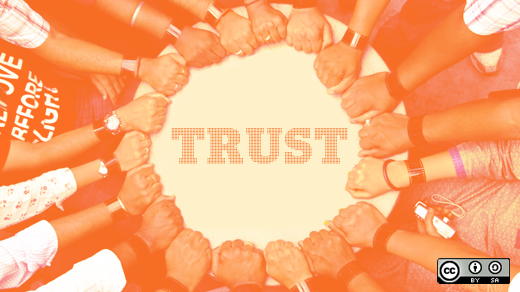Open source communities are some of the most passionate organizations I've ever seen. Their members care deeply about the work they do (often voluntarily), and that passion drives incredible innovations. That's no small feat, because open source communities are often collaborating in the face of geographic, cultural, and technological barriers that can lead to unfortunate misunderstandings.
And yet open source communities are also extraordinarily resilient. Some of them have found clever ways to refocus their energies and eliminate sources of conflict.
I really like one in particular: "Always assume positive intent." It's something I occasionally hear community members say to each other when passions are running high.
Here's what it means to me.
Motivation and action
Motivations are invisible. Actions, on the other hand, are very visible. The way we connect the two is important.
When people collaborate—when they invest in a project together and all want it to succeed—they're constantly observing and reacting to the actions they see from others. But they're making assumptions about what they can't see: the reasoning behind those actions, the motivations or intentions.
People that have worked together for long periods of time have developed a deep understanding of one another's personalities, habits, and approaches to challenges. They "get" one another. That means they've learned to make positive connections between what they observe co-workers doing (the visible) and what they assume those co-workers are thinking when they're doing it (the invisible).
In open organizations, where people are constantly reaching across teams (even beyond organizational boundaries) to link with folks they may be meeting for the first time, making productive connections between action and motivation is critical. I've learned that the best way to create those productive relationships is to assume the best in what I can't see—that is, to assume people are acting with positive intent.
This means assuming, from the start, that people are:
- trying to help you—not trying to undercut or deceive you
- trying to make a project better for everyone—not to bend it toward their own priorities or vision
- doing the best they can with the data, resources, and perspective they have, to make the most sound choices they can—not acting without consideration, or even with malice
This strategy has worked well for me.
Shifting assumptions
For example, a few months ago I held a town hall meeting with all Red Hat associates. We were on the cusp of a new calendar year, we had plenty of ambitious goals in front of us, and I wanted to get a sense for what people were thinking and feeling before the holidays.
So I scheduled the meeting. Immediately, the emails poured in.
"What's the big announcement?" people asked me. "Can you brief me on the big news in advance?" said others. "How should I prepare my teams for what you're going to say?" others wondered. I quickly realized that these people were making some drastic assumptions about my motivations for calling the meeting.
So I needed to follow my own advice and ask myself: Why would people act this way? By assuming positive intent on their part, I was able to realize that they were simply trying to do what all good open leaders do: gather appropriate data ahead of big decisions so they could set some context for their teammates before I surprised them with something.
But I had no big announcement to share. When people realized this, they were better able to make positive inferences about my intentions too. (By the way, the town hall was great. Thousands of associates attended and I was able to answer more than a dozen of the pointed and thoughtful questions they asked. I learned a lot.)
Fostering positivity
Open leaders need to create environments where assuming positive intent is a "default" mode of thinking for everyone. It leads to more productive teamwork, a more open working environment, and outcomes that are more satisfying to more associates. I'll be the first to admit that it's not easy to do. But I do have a few tips for leaders hoping to foster this kind of attitude:
- Create a culture in which common goals are obvious and transparent. Record them publicly, track them, and circle back to them repeatedly. This way, everyone will know that their teammates know the group's collective mission and are more likely to assume they're working with the same intentions.
- Model the behavior you want to see. Assume positive intent on behalf of your leadership teams and associates. At Red Hat, our People team has developed some great strategies for making this kind of thinking the norm.
- Practice patience. Before jumping to conclusions about people's intentions, stop and ask yourself about their frames of reference. Do they share the same context you do? And do you understand everything they do? Sometimes, others simply don't see what you see: Something that's a big deal to you might not be to someone else. Take the time to initiate a conversation and align your priorities.
I'm certainly not suggesting that everyone, everywhere, in every organization always acts with positive intent. Sometimes they don't! But I've found it's best to trust people. Let them prove their negative intentions to you, rather than assuming the worst.






2 Comments